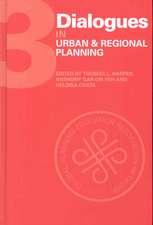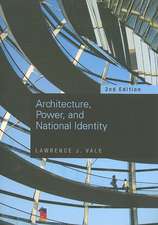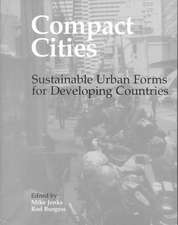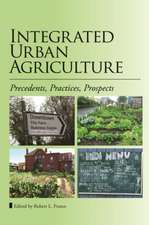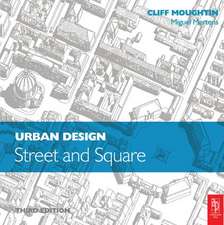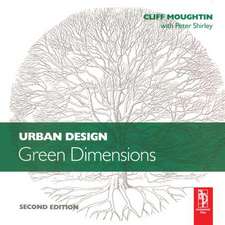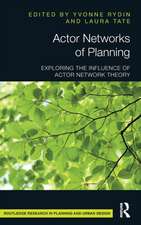The Social Fabric of Cities: Design and the Built Environment
Autor Vinicius M. Nettoen Limba Engleză Hardback – sep 2016
In a systematic attempt to bring urban analysis and research from the social sciences together, the book is organised around three vital yet relatively neglected dimensions in the social and material shaping of cities: (i) Cities as systems of encounter: an approach to urban segregation as segregated networks; (ii) Cities as systems of communication: a view of shared spaces as a means to association and social experience; (iii) Cities as systems of material interaction: explorations on urban form as an effect of interactivity, and interactivity as an effect of form.
Visit the author’s website at: http://socialfabric.city/
Din seria Design and the Built Environment
-
 Preț: 340.37 lei
Preț: 340.37 lei - 18%
 Preț: 1027.58 lei
Preț: 1027.58 lei - 13%
 Preț: 338.33 lei
Preț: 338.33 lei -
 Preț: 492.20 lei
Preț: 492.20 lei - 14%
 Preț: 338.33 lei
Preț: 338.33 lei -
 Preț: 469.34 lei
Preț: 469.34 lei -
 Preț: 469.34 lei
Preț: 469.34 lei - 13%
 Preț: 338.33 lei
Preț: 338.33 lei -
 Preț: 471.42 lei
Preț: 471.42 lei -
 Preț: 349.15 lei
Preț: 349.15 lei -
 Preț: 489.26 lei
Preț: 489.26 lei -
 Preț: 469.34 lei
Preț: 469.34 lei - 14%
 Preț: 260.54 lei
Preț: 260.54 lei - 12%
 Preț: 301.97 lei
Preț: 301.97 lei - 15%
 Preț: 259.10 lei
Preț: 259.10 lei - 12%
 Preț: 328.00 lei
Preț: 328.00 lei - 30%
 Preț: 768.79 lei
Preț: 768.79 lei -
 Preț: 389.31 lei
Preț: 389.31 lei - 18%
 Preț: 1006.43 lei
Preț: 1006.43 lei - 26%
 Preț: 876.36 lei
Preț: 876.36 lei -
 Preț: 382.91 lei
Preț: 382.91 lei -
 Preț: 416.22 lei
Preț: 416.22 lei - 17%
 Preț: 246.33 lei
Preț: 246.33 lei - 28%
 Preț: 800.60 lei
Preț: 800.60 lei
Preț: 827.24 lei
Preț vechi: 1107.08 lei
-25% Nou
Puncte Express: 1241
Preț estimativ în valută:
158.29€ • 165.71$ • 130.98£
158.29€ • 165.71$ • 130.98£
Carte tipărită la comandă
Livrare economică 05-19 aprilie
Preluare comenzi: 021 569.72.76
Specificații
ISBN-13: 9781472470669
ISBN-10: 1472470664
Pagini: 266
Ilustrații: 63
Dimensiuni: 174 x 246 x 20 mm
Greutate: 0.86 kg
Ediția:1
Editura: Taylor & Francis
Colecția Routledge
Seria Design and the Built Environment
Locul publicării:Oxford, United Kingdom
ISBN-10: 1472470664
Pagini: 266
Ilustrații: 63
Dimensiuni: 174 x 246 x 20 mm
Greutate: 0.86 kg
Ediția:1
Editura: Taylor & Francis
Colecția Routledge
Seria Design and the Built Environment
Locul publicării:Oxford, United Kingdom
Cuprins
Introduction: Threading the social and the spatial, Part I : Cities and the fabric of encounter, 1. Restricting interaction, 2. Segregated networks in the city, Part II: Cities and the fabric of communication, 3. Communication and space, 4. Urbanity as a dialogical achievement, 5. (Re)claiming the city: polis and the public sphere, Part III: Cities and the fabric of material interaction, 6. Notes on the implications of form, 7. The social effects of architecture, 8. The city as result: unintended consequences of architectural choices
Notă biografică
Vinicius M. Netto holds a PhD in Advanced Architectural Studies (University College London, UCL), and is currently working as Assistant Professor at Universidade Federal Fluminense (UFF), Rio de Janeiro state, Brazil.
Recenzii
Linking the physical to the social city is the challenge of our times. This is one of the first attempts to systematically do so, and Netto brilliantly succeeds in showing how encounters, segregation, movement and interaction are reflected in our understanding of the form and function of the city.
Michael Batty, CASA, University College London
In our fast-paced, empirically-driven research world, it is a rare treat to come across a theoretical book that merits pause and reflection, especially when written by a young scholar who has had the patience to mature it for a decade before granting it to us. Vinicius M. Netto’s meticulously crafted conceptual framework provides us with the tools to rethink some of the fundamental elements of our everyday research and teaching practice: the interscalar and increasingly complex relations between individual and collective bodies and the spaces of place and flow that shape and are shaped by our interactions. Netto offers practical reasons and philosophical ammunition in support of the battle to reclaim the city. This book is an admirable accomplishment.
Clara Irazábal, Columbia University
The city is at the nexus of the socio-economic, technological and cultural networks that are transforming contemporary social life. Vinicius Netto explains why our understanding of this complex process is likely to remain limited so long as the false opposition of materiality and meaning goes inadequately challenged in social theories of the city. His response is an original account of social practice as a communicative act premised on the materiality of urban systems. This highly interdisciplinary and intelligent study comes as a breath of fresh air to urban studies and should challenge entrenched epistemological positions.
Sam Griffiths, University College London
Michael Batty, CASA, University College London
In our fast-paced, empirically-driven research world, it is a rare treat to come across a theoretical book that merits pause and reflection, especially when written by a young scholar who has had the patience to mature it for a decade before granting it to us. Vinicius M. Netto’s meticulously crafted conceptual framework provides us with the tools to rethink some of the fundamental elements of our everyday research and teaching practice: the interscalar and increasingly complex relations between individual and collective bodies and the spaces of place and flow that shape and are shaped by our interactions. Netto offers practical reasons and philosophical ammunition in support of the battle to reclaim the city. This book is an admirable accomplishment.
Clara Irazábal, Columbia University
The city is at the nexus of the socio-economic, technological and cultural networks that are transforming contemporary social life. Vinicius Netto explains why our understanding of this complex process is likely to remain limited so long as the false opposition of materiality and meaning goes inadequately challenged in social theories of the city. His response is an original account of social practice as a communicative act premised on the materiality of urban systems. This highly interdisciplinary and intelligent study comes as a breath of fresh air to urban studies and should challenge entrenched epistemological positions.
Sam Griffiths, University College London
Descriere
Ambitious in scope and bringing together ideas from the fields of sociology, economics, human geography, ethics, political and communications theory and planning, this book deals with some key subjects in urban design: the multi-dimensional effects of the spatial form of cities, ways of appropriating urban space, and the different material factors involved in the emergence of social life.





